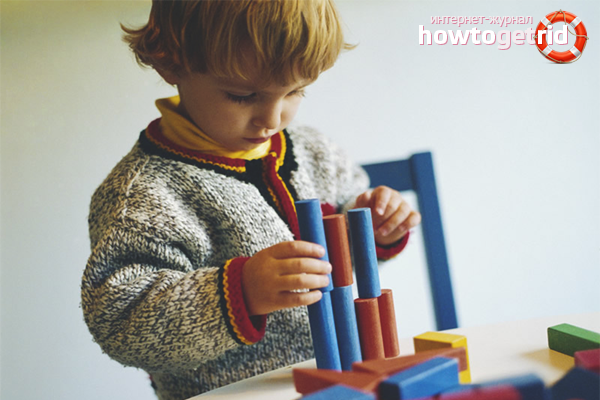The content of the article
Due to age, children are not able to focus their attention arbitrarily. This is especially true for younger students who are interested in everything at one moment. Parents often set out to instill attentiveness to their child, and this is the right decision. Concentrated people successfully cope with the task, without experiencing difficulties. Inattention can be overcome through interesting games and constant monitoring, we will consider important aspects of education.
Practical advice for parents
- Look for new non-standard ways to attract the attention of the child. This can be done with the help of a clear and unexpected example, which is accompanied by a lot of emotions on your part. If the baby is busy with a certain business, concentrating completely on it, do not rush to give him a new task, so as not to distract.
- Choose an appropriate time for classes. The room should not have bright toys that will not allow the baby to concentrate. Do not start the exercise if music is playing in the next room or the household is noisy. Arrange in advance with your family that they will not disturb you and flicker before your eyes so as not to confuse the child.
- Before giving the baby a specific task, evaluate it from the point of view of the child. Attention enhancement exercise should be easily accessible, intelligible, fun, and friendly. It is advisable to build a logical chain for the child in the form of step-by-step instructions.
- During the exercises for concentration, watch your own emotions. In no case do not frown if the script does not require it. Do not raise your voice, do not reproach the child. Throughout the lesson, you need to be friendly and restrained, so that the baby feels comfortable. Smile, do not skimp on compliments, screech enthusiastically.
Child Attention Exercises
Find a toy
Take 5 toys, place them in front of the child. Ask the child to close his eyes, and then hide one object. Now the child needs to open his eyes and say which toy is missing. Over time, you will notice how the baby begins to concentrate with ease. After this point, it is worth increasing the number of items to 7 or 10.
Repeat the sequence
Take colored cardboard, cut out of it 2 large red circles, 2 green squares, 3 colorful triangles and always 2 yellow stars. Spread all objects on an equal surface in the order you see fit. Sit the child opposite, give him 3 minutes so that the baby remembers the combination. Ask the child to close his eyes, mix the figures in one pile. Instruct the child to reproduce the previously seen sequence. It is very important for you to remember where each figure was, so as not to confuse the child. For starters, you can arrange clippings in ascending order or color, and then use a chaotic order.
Underline letters
Print the text on large pages in large print or take a regular children's book. Ask the child to cross out (underline) all the letters O and B. During classes, make sure that the child looks through the words line by line, and does not run randomly through the sheet with his eyes. On average, an exercise is performed for 5 minutes, for these purposes, turn on the stopwatch to show the severity of the assigned task. Children 6-8 years old must look at the allotted time for about 300-400 characters, while the number of errors should not exceed 10. It is advisable to do the exercise every day 2 times. Over time, it is necessary to complicate the task by adding 2 more letters - A and B.
Find 5 differences
In any stationery store children's books are sold for the development of concentration and attention. Usually they consist of 12-15 sheets, 2 figures with minor differences are drawn on each revolution. Ask your child to carefully look through the pictures and find the differences between the drawn characters. So that your child’s interest does not run out, purchase not 1, but 5-7 books, process them in turn. Also sold are publications where it is necessary to find the same objects. Use 2 types alternately to significantly increase efficiency.
Describe the subject
Before the next walk, arrange with the baby that from now on you have a responsible mission. Specify that at some point you will be pointing at an object, and the child should concentrate on it. Come up with a specific command that the two of you will understand. The exclamations “Attention!”, “Ale op!” Will do. and others. At first, it is worth focusing only on large objects, whether it be a colorful building, a blue car or a horse carriage. After a month of daily training, complicate the task by choosing smaller items. In a couple of weeks, add a new paragraph: ask the baby to describe the seen object. At the same time, he should pay attention to color, shape and minor details. Praise your child more often, but do it wisely. For example, he noticed a dog and specified that it had white paws. Praise and say, “You are so attentive! I really liked that you saw white paws, but I did not. Keep up the good work! ” If a child realizes that his attention is meritorious, he will begin to try many times better, and training every day will be more effective.
Find a friend
The exercise is designed to be performed in a large circle of children, psychologists and teachers often resort to it. You are a commissar, children are helpers. Put the kids in a circle, and sit back at a distance to carefully monitor your child. Highlight a specific child, for example, a boy in a blue shirt. Then say the phrase “Attention, assistant in a blue shirt, please go to the commissioner!”. The children will begin to examine each other, then the assistant goes out and continues the game, but now he is the commissioner. It is advisable to choose not small items such as jeans or a shirt, but something small. Suitable for fasteners on shoes or watches, pendant, colored buttons.
Follow the rules of the road
Everyone can participate: grandparents, mothers, fathers, friends. The essence of the game is the proper regulation of car traffic. Draw a crossroads on the asphalt, indicate on it the pedestrian crossings, “Stop” signals and other signs that the children will understand. Put one lead at the center. Divide the participants into 2 groups - pedestrians and drivers. In which of them your child will be unimportant, everyone needs to concentrate. At the signal of the traffic controller, cars begin to ride, and pedestrians cross the road. Lead must monitor compliance with traffic rules. Who breaks the rules - crashes out of the game.
During games aimed at improving concentration, try to express emotions. Clap your hands, praise the child, do everything so that the delight from the event is transmitted to your baby. Follow the correct implementation of exercises, increase difficulty after fixing certain skills.
Video: how to develop memory and attention










Submit